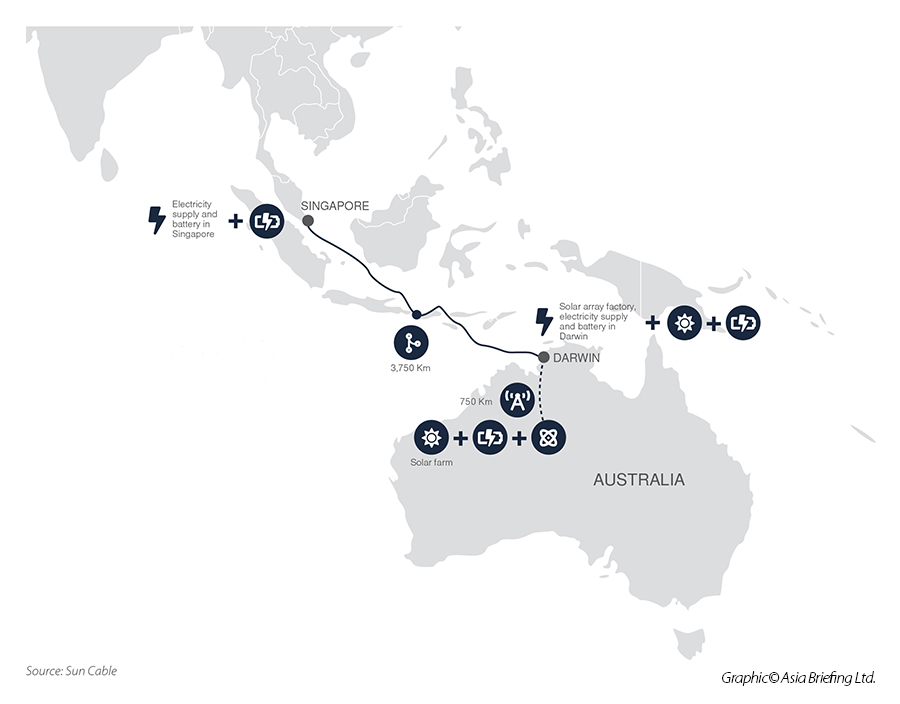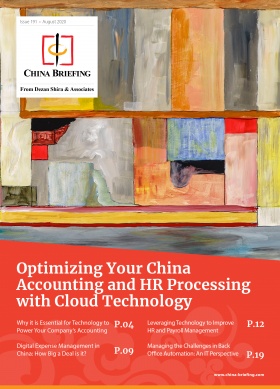The Australia-Asian PowerLink: Encouraging Investments in ASEAN Renewable Energy
The Australia-Asia PowerLink will deliver power generated from the world’s biggest solar farm in Australia to Singapore through overhead and undersea cables.
The project, estimated to cost A$30 billion (US$22.4 billion), involves the development of a solar plant covering over 12,000 hectares in the town of Tennant Creek, approximately 990km from the town of Darwin. The harnessed renewable energy of 3GW is then transmitted to Darwin before being transferred to a 4,500km, 2.2GW undersea cable to Singapore via Indonesia. It is expected to supply its first batch of electricity to Darwin in 2026, and to Singapore in 2027, with full capacity in 2028. Additionally, a battery unit capable of storing between 36 and 42 Gigawatt hours will also be constructed on the solar panel field site to store excess energy.
Part of Sun Cable’s agreement with Indonesia is the promise of investments, employment, and sharing of crucial technologies. Sun Cable will invest a total of US$2.5 billion of which US$1 billion will be used on procuring services and equipment, such as lithium and other battery components.Once completed, the Australia-Asia PowerLink is expected to supply 15 percent of Singapore’s energy requirements. Currently, about 95 percent of the country’s electricity is produced from natural gas, which it imports from mainly Malaysia and Indonesia – Singapore is a country with very few natural resources.
ASEAN’s increasing energy requirements
ASEAN is fast becoming a heavyweight in global energy with demand growing at twice the pace as it is in China. By 2040, the region’s energy demand is set to grow by 60 percent.
The main driver of this growth is rising incomes, and rapid industrialization and urbanization. Countries in ASEAN saw huge migration from the countryside to urban areas over the last two decades as the regional shift from agriculture to industrialization began to take shape. As a result, 52 percent of the region’s population now lives in urban areas giving rise to new consumer spending on conveniences and technologies that have become an important part of modern society, such as automobile and air conditioner ownership. Faced with these pressures, regional governments have intensified their efforts to remove obstacles to energy investments and ensure energy deficits are not a hindrance to businesses.
Also, by 2040, ASEAN will see a population increase of almost 120 million – to reach 770 million – contributing to a regional GDP of US$20 trillion. And the rapid growth of total energy supply will transform ASEAN from a net exporter into a net importer of fossil fuels. Oil demand will surpass nine million barrels per day from the current average of seven million barrels per day and natural gas consumption is expected to rise by 60 percent. Further, ASEAN is one of the few regions in the world where coal-fired electricity generation has been expanding, with close to 20GW of new capacity under construction. These projects are mainly in Indonesia (a major producer), Vietnam, and the Philippines.
As such, with not enough indigenous fossil fuel resources, ASEAN’s net energy trade deficit could be more than US$300 billion per year and lead to important energy security implications.
Australia-Asia PowerLink can spur renewable energy investments in ASEAN
The Australia-Asia PowerLink should be a wake-up call for ASEAN members to spur renewable energy investments, particularly since the region’s renewable energy potential goes beyond just solar energy.
To revive the pandemic hit economies as well as improve the renewable energy capacity, ASEAN has set a target of integrating 23 percent of renewable energy into its primary energy supply under the ASEAN Plan of Action for Energy Cooperation (APAEC) 2021-2025. Indonesia, Vietnam, the Philippines, Thailand, and Malaysia currently account for 84 percent of the installed renewable energy capacity in ASEAN and are expected to account for the largest renewable energy expansion.
Further, the volatility of fossil fuel prices due to the COVID-19 pandemic and the Russia-Ukraine war has significantly impacted ASEAN countries, resulting in increased fuel prices and inflation, therefore reinforcing the need for a more driven transition towards renewable energy consumption.Indonesia
Indonesia has the potential to generate 788,000 MW from renewable energy sources, such as geothermal, wind, solar, and tidal. This is more than 14 times the country’s current electricity consumption. Thanks to its position in the ‘ring of fire’, Indonesia has 40 percent of the world’s geothermal stores, and its vast maritime area could provide 75,000 MW of power.
Harnessing such potential will require over US$16 billion in investments per year.
Vietnam
Vietnam’s more than 3,000km coastline provides the country with vast wind resources, and according to the World Bank, more than 39 percent of Vietnam experiences wind speeds of more than 6 meters per second, or the equivalent of 512 GW of capacity. In addition to wind, Vietnam has solar photovoltaic (PV) capacity, which increased from 86 MW in 2018 to 16,500 MW in 2020.
Thailand
Thailand currently has installed over 15 GW of renewable energy, which is forecasted to rise to 63 GW by 2030, positioning the country as one of the leaders in renewable energy. The majority of its current capacity comes from hydro, solar PV, and bioenergy, with the wind also seeing significant growth of 24 percent in annual installed capacity.
Malaysia
Malaysia plans to increase its share of renewable energy in its energy mix to 31 percent by 2025 and 40 percent by 2035. The government’s primary focus will be on Peninsular Malaysia as it accounts for 80 percent of the country’s electricity demand.
Hydropower technologies dominate Malaysia’s renewable energy landscape, accounting for 86 percent of total capacity while solar PV has the highest technical potential due to its increasing affordability. The government has an overarching ambition to increase the contribution of non-hydropower renewables to 20 percent of the energy mix by 2025. Malaysia presents an encouraging environment for foreign investments in this sector as the country aims to gradually liberalize its power market segments through reforms under the Malaysia Electricity Supply Industry (MESI) 2.0 program.
Further Reading
- Scotland Eager to Support Offshore Wind Power Projects in Vietnam
- Thailand Issues New Incentive Package for Electric Vehicle Industry
- Singapore Signs Digital Trade Deal With the UK
About Us
ASEAN Briefing is produced by Dezan Shira & Associates. The firm assists foreign investors throughout Asia and maintains offices throughout ASEAN, including in Singapore, Hanoi, Ho Chi Minh City, and Da Nang in Vietnam, Munich, and Esen in Germany, Boston, and Salt Lake City in the United States, Milan, Conegliano, and Udine in Italy, in addition to Jakarta, and Batam in Indonesia. We also have partner firms in Malaysia, Bangladesh, the Philippines, and Thailand as well as our practices in China and India. Please contact us at asia@dezshira.com or visit our website at www.dezshira.com.
- Previous Article Indonesia’s GoTo Goes Public, Market Capitalization of US$32bn
- Next Article Vietnam’s Border Reopening: Implications for Businesses








